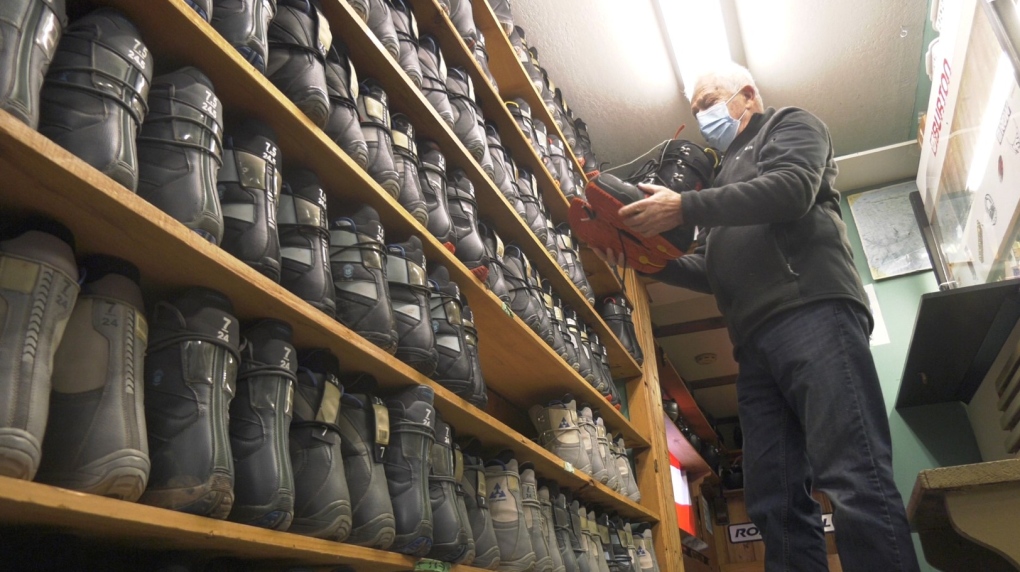Local tourism hit with more challenges

Businesses reliant on winter tourism are tackling another wave of the pandemic.
At Blue Mountain, the parking lots, village, and slopes were filled with tourists, but it was just a day trip for some.
"It has been very challenging," said Sigi Waldner, the owner of Alpine Sports.
Waldner has been running a ski and snowboard rental shop in the Blue Mountains for decades, and he says, although he has a loyal customer base, the past two winters have been slower than prior years.
"We are suffering a little. Twenty-five per cent of our business is foreign business," said Waldner.
On Monday, the Tourism Industry Association of Canada reported that the number of international tourists has led to a significant financial drop for the tourism sector due to pandemic restrictions and advisories.
"In the year before the pandemic hitting, people spent $105 billion to travel in Canada and within Canada," said Beth Potter, the CEO and President of Tourism Industry Association of Canada.
Potter says that number has been nearly cut in half during the pandemic.
She says international tourists are essential to help the industry dig out of the financial hole.
"What's really going to put us over the edge of where we used to be is when we see the return of U.S. travellers and international travellers," said Potter.
She says domestic travellers make up 80 per cent of the Canadian tourism industry. Although, she says international tourists spend more than double on average.
"On average, it's about $1,200 by comparison to about $500," said Potter.
Potter says the tourism industry has lost about 400,000 employees due to the pandemic. She noted that of every one million dollars spent by tourists, it creates 13 new jobs along with its 2% contribution to GDP.
As the tourism industry navigates the pandemic, regional health units are working to stop the spread of the emerging omicron variant.
Over the weekend, the Grey-Bruce region recorded 101 COVID-19 cases. A concerning trend that the region's top doctor says may lead to many people being infected.
"The projected numbers would indicate that many of us will be infected," said Dr. Ian Arra, the medical officer of health for Grey-Bruce.
He went on to say that there is a silver lining to the rise of the Omicron variant. According to Dr. Arra, although the new strain is highly infectious, it's less severe.
"This might indicate that we might be at the end tail of this pandemic earlier. My own projection would be two to three months," said Dr. Arra via Zoom.
As daily case numbers in the province hover around 10,000, health experts are concerned that it could lead to overwhelming hospitals because the virus is more transmissible.
On Monday, the province reported 176 people were in the ICU with COVID.
"I don't want anyone to have omicron or covid, but I do believe our health system can manage if we can keep the ICU numbers under 200," said Dr. Sohail Gandhi the past president of the Ontario health association.
Dr. Gandhi says the keys to keeping numbers low are following health protocols and getting vaccinated with a booster shot to help prevent severe illness.
CTVNews.ca Top Stories

Halifax police say Walmart employee's death isn't suspicious; no details released
Police in Halifax say the death of a Walmart employee who was found inside an oven in the store last month is not suspicious, but they are refusing to release any additional details.
Canada Post, union to meet mediator Monday in effort to end strike
Canada Post and the Canadian Union of Postal Workers (CUPW) are meeting with a special mediator for the first time Monday to continue talks as they enter the fourth day of a national strike.
Parts of Canada will see up to 30 centimetres of snow. Here's where
Canadians are bracing for a chilly start to the week as snowfall and other wintry conditions are expected to make landfall across western and eastern provinces.
9 injured, including 2 critically, after stolen vehicle collides with TTC bus in Toronto: police
Nine people were injured, including two critically, after a stolen vehicle collided with a TTC bus in North York early Monday morning, Toronto police say.
Taylor Swift Eras Tour: Ticket scam west of Toronto costs 40 people more than $70K
Dozens of people in Halton Region are out tens of thousands of dollars after buying fake or nonexistent tickets to Taylor Swift’s Eras Tour dates in Toronto, police say.
'Saving lives is not controversial': B.C. doctors set up 'unsanctioned' overdose prevention sites at hospitals
A group of physicians are setting up unofficial overdose prevention sites outside two Vancouver Island hospitals Monday, aiming to help people struggling with addiction – while also sending a message to the government.
Israeli airstrike hits central Beirut near key government buildings and embassies
An Israeli airstrike late Monday struck a densely populated residential area in Lebanon's capital close to the U.N. headquarters, Parliament, the prime minister's office and several embassies.
Tropicana fans are ditching the brand after a bottle redesign
Tropicana customers are in revolt over an orange juice bottle redesign. Again.
Moscow warns U.S. over allowing Ukraine to hit Russian soil with longer-range weapons
The Kremlin warned Monday that President Joe Biden's decision to let Ukraine strike targets inside Russia with U.S.-supplied longer-range missiles adds "fuel to the fire" of the war and would escalate international tensions even higher.































